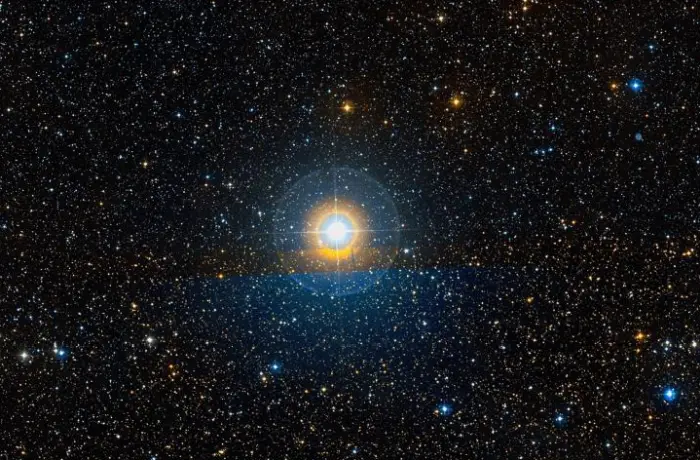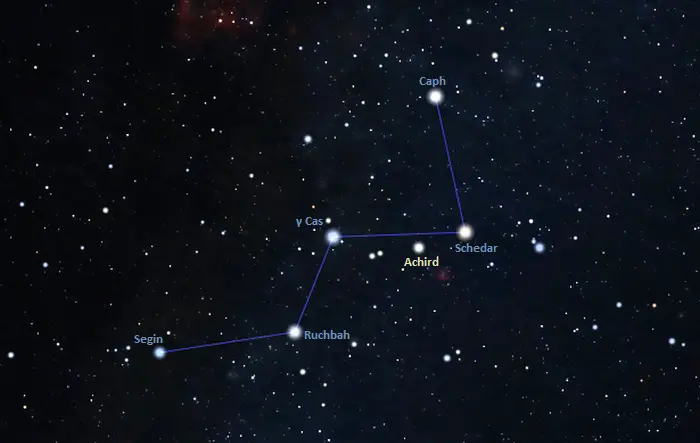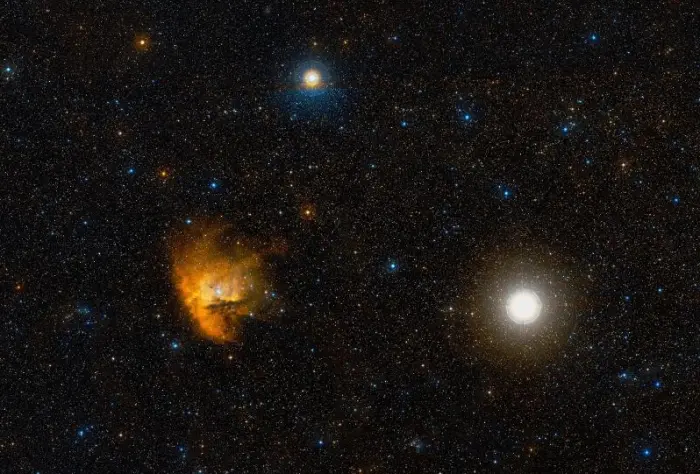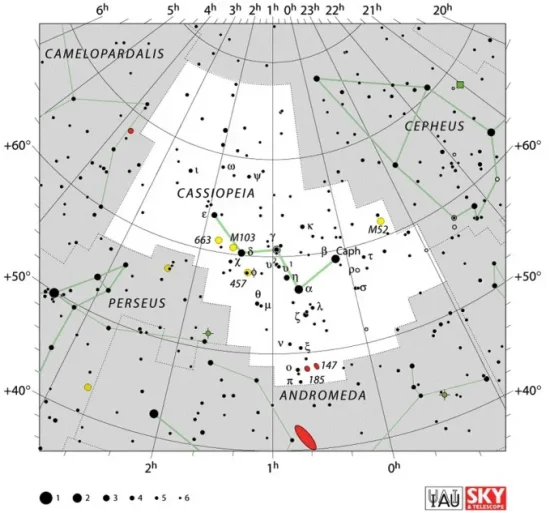Achird, Eta Cassiopeiae (η Cas), is a binary star located 19.32 light-years away in the northern constellation Cassiopeia. It is the nearest star in Cassiopeia to Earth. With an apparent magnitude of 3.44, it is the sixth brightest star in the constellation, after the five stars of Cassiopeia’s W.
Star system
Eta Cassiopeiae is a binary star system composed of Eta Cassiopeiae A, a yellow main sequence star of the spectral type G0 V, and Eta Cassiopeiae B, an orange main sequence star with the stellar classification K7 V. The primary star has an apparent magnitude of 3.44 and the secondary star shines at magnitude 7.51. Only Eta Cas A is visible to the unaided eye.
The two components are separated by 11.9939 arcseconds in the sky, corresponding to an average physical distance of 71 astronomical units (AU). They take 480 years to complete an orbit around the common centre of mass. The stars can be easily resolved in a small telescope.
Both stars show only half the Sun’s metallicity (abundance of elements that are heavier than hydrogen and helium).

Achird (Eta Cassiopeiae), image: Wikisky (DSS2)
Eta Cassiopeiae A and B have a large orbital eccentricity (0.497). Their orbit takes them within 36 AU of each other and as far apart as 106 AU. At their periapsis (closest approach), the distance between them (36 AU) is comparable to that between the Sun and Neptune (30 AU).
The primary component, the yellow dwarf formally known as Achird, has very similar properties to the Sun. It has a mass of 0.95 ± 0.08 solar masses and the same radius as the Sun. With a surface temperature of 6,010 K, it shines with 1.2321 solar luminosities. The star spins at 3.15 km/s. It has an estimated age of 5.4 billion years.
The companion, the orange dwarf Eta Cassiopeiae B, has 57% of the Sun’s mass and a radius 66% that of the Sun. It shines with only 6.46% of the Sun’s luminosity with an effective temperature of 4,036 K.
Facts
The binary nature of Eta Cassiopeiae was discovered by the German-born British astronomer Sir William Herschel in August 1779. More recently, the primary component was proposed to be a spectroscopic binary star, but the presence of a closer companion has not been confirmed.
The Washington Double Star Catalog lists six dimmer companions, but these are optical companions that only appear in the same line of sight as Eta Cassiopeiae A and B. They are not physically related to the Achird system.
Name
The name Achird (pronunciation: /ˈeɪtʃərd/) comes from Czech astronomer Antonín Bečvář’s Skalnaté Pleso Atlas of the Heavens (Atlas Coeli Skalnaté Pleso 1950.0), published in 1950. The origin of the name is unknown and there are no records of it ever being used for the star before 1950.
The International Astronomical Union’s (IAU) Working Group on Star Names (WGSN) approved the name on September 5, 2017. The name formally applies only to the primary component, Eta Cassiopeiae A, but is informally used for the whole star system.
In traditional Chinese astronomy, Achird was known as 王良三 (Wáng Liáng sān), the Third Star of Wang Liang. It formed the Wang Liang asterism with Caph (Beta Cassiopeiae), Kappa Cassiopeiae, Schedar (Alpha Cassiopeiae), and Lambda Cassiopeiae. The asterism was part of the larger Legs mansion, which represented the tail of the White Tiger.
Location
Achird is very easy to find because it appears in the region of Cassiopeia’s W, one of the most recognizable northern asterisms. It appears near Schedar, the constellation’s brightest star.
Schedar is the bottom right star of Cassiopeia’s W and Achird is the brightest star in the region between Schedar and Gamma Cassiopeiae, the central star of the W.

The location of Achird (Eta Cassiopeiae), image: Stellarium
Achird and Schedar can be used to find the Pacman Nebula (NGC 281, IC 11), a bright emission nebula associated with the open cluster IC 1590. The nebula lies 9,500 light-years away and has an apparent size of 35 arcminutes, corresponding to a physical diameter of 96 light-years.

Achird (top), Schedar (right) and Pacman Nebula (left), image: Wikisky (DSS2)
Constellation
Achird is located in the constellation Cassiopeia. It is part of the celestial Queen’s girdle.
Cassiopeia (the Seated Queen) is one of the most prominent northern constellations, along with Ursa Major (the Great Bear) and Cygnus (the Swan). It is the 25th largest constellation in the sky, stretching across 598 square degrees. It is one of the 48 Greek constellations, listed by the astronomer Claudius Ptolemy of Alexandria in his Almagest in the 2nd century CE.
In Greek mythology, the constellation is associated with the vain and boastful Queen Cassiopeia, mother of Andromeda and wife of Cepheus. Cassiopeia’s five brightest stars form a bright W that makes the constellation easy to recognize. The W asterism is visible throughout the year for observers in the northern hemisphere.

Cassiopeia constellation map by IAU and Sky&Telescope magazine (Roger Sinnott & Rick Fienberg) (CC BY 3.0)
Schedar (Alpha Cassiopeiae), the constellation’s brightest star, is an orange giant that shines at magnitude 2.240 from a distance of 228 light-years.
Other notable stars in Cassiopeia include the variable yellow-white giant Caph (Beta Cassiopeiae), the hot blue eruptive variable star Gamma Cassiopeiae, the variable blue supergiant Kappa Cassiopeiae, the yellow hypergiants Rho Cassiopeiae and V509 Cassiopeiae, the eclipsing variable star AO Cassiopeiae, and the yellow-white supergiant Phi Cassiopeiae.
Cassiopeia contains many bright deep sky objects. These include the open star clusters Messier 52, Messier 103, Caroline’s Rose Cluster (NGC 7789) and the Owl Cluster (NGC 457), the large Heart and Soul nebulae, the Fish Head Nebula (IC 1795), and the emission nebulae known as the Pacman Nebula (NGC 281) and the Bubble Nebula (NGC 7635). The constellation also hosts the supernova remnants Cassiopeia A and Tycho’s Supernova, and the starburst irregular galaxy IC 10, a member of the Local Group of galaxies.
The best time of the year to see the stars and deep sky objects in Cassiopeia is during the month of November, when the constellation appears high above the horizon in the early evening. The entire constellation can be seen from locations between the latitudes 90° N and 20° S.
The 10 brightest stars in Cassiopeia are Gamma Cassiopeiae (mag. 1.6 – 3.0), Schedar (Alpha Cas, mag. 2.24), Caph (Beta Cas, mag. 2.28), Ruchbah (Delta Cas, mag. 2.68), Segin (Epsilon Cas, mag. 3.37), Achird (Eta Cas, mag. 3.44), Fulu (Zeta Cas, mag. 3.66), 50 Cassiopeiae (mag. 3.95), Kappa Cassiopeiae (mag. 4.16), and Theta Cassiopeiae (mag. 4.334).
Achird – Eta Cassiopeiae
| Spectral class | G0 V + K7 V |
| Variable type | RS CVn? |
| Apparent magnitude | 3.44/7.51 |
| Constellation | Cassiopeia |
| Right ascension | 00h 49m 06.29070s |
| Declination | +57° 48′ 54.6758″ |
| Names and designations | Achird, Eta Cassiopeiae, η Cassiopeiae, η Cas, 24 Cassiopeiae, BD+57°150, GJ 34, ADS 671, CCDM J00491+5749, IDS 00430+5717, WDS J00491+5749 |
Eta Cassiopeiae A
| Spectral class | G0 V |
| U-B colour index | +0.02 |
| B-V colour index | +0.58 |
| Apparent magnitude | 3.44 |
| Absolute magnitude | 4.57 |
| Distance | 19.32 ± 0.02 light-years (5.923 ± 0.006 parsecs) |
| Parallax | 168.8322 ± 0.1663 mas |
| Radial velocity | +8.404 ± 0.0004 km/s |
| Proper motion | RA: 1,078.609 ± 0.127 mas/yr |
| Dec.: -551.133 ± 0.153 mas/yr | |
| Mass | 0.95 ± 0.08 M☉ |
| Luminosity | 1.2321 ± 0.0074 L☉ |
| Radius | 1.00 R☉ |
| Temperature | 6,010 K |
| Metallicity | -0.31 dex |
| Age | 5.4 ± 0.9 billion years |
| Rotational velocity | 3.15 km/s |
| Surface gravity | 4.4 ± 0.3 cgs |
| Right ascension | 00h 49m 06.2945942922s |
| Declination | +57° 48′ 54.638239716″ |
| Names and designations | Achird, Eta Cassiopeiae A, η Cassiopeiae A, η Cas A, 24 Cassiopeiae A, HD 4614, HR 219, HIP 3821, SAO 21732, Wolf 24, Struve 60, GCTP 155, LHS 123, LFT 74, AG+57 81, LTT 10287, NLTT 2690, PPM 25718, PLX 155, GC 962, GCRV 447, SBC7 31, LSPM J0049+5748, AP J00490622+5748545, ASCC 159214, CNS5 239, N30 163, 2E 191, 2E 0046.1+5733, JP11 419, IRC +60019, SPOCS 41, PM 00461+5733, 1RXS J004904.0+574917, ROT 6014, ROT 3488, TD1 443, TIC 445258206, UBV 650, WEB 675, USNO 793, USNO-B1.0 1478-00036288, Zkh 15, IRAS 00461+5732, 2MASS J00490622+5748545, TYC 3663-2669-1, Gaia DR2 425040000951479424, Gaia DR3 425040000962559616 |
Eta Cassiopeiae B
| Spectral class | K7 V |
| U-B colour index | 1.03 |
| B-V colour index | 1.39 |
| Apparent magnitude | 7.51 |
| Distance | 19.331 ± 0.002 light-years (5.9270 ± 0.0008 parsecs) |
| Parallax | 168.7186 ± 0.0216 mas |
| Radial velocity | 8.6837 ± 0.1 km/s |
| Proper motion | RA: 1144.693 ± 0.18 mas/yr |
| Dec.: -469.668 ± 0.19 mas/yr | |
| Mass | 0.57 ± 0.07 M☉ |
| Luminosity | 0.0646 L☉ (0,0551 – 0.0777 L☉) |
| Radius | 0.66 R☉ |
| Temperature | 4,036 ± 150 K |
| Right ascension | 00h 49m 05.1918602391s |
| Declination | +57° 49′ 04.174468559″ |
| Names and designations | Eta Cassiopeiae B, η Cassiopeiae B, η Cas B, 24 Cassiopeiae B, LHS 122, LTT 10288, NLTT 2689, GCRV 448, LFT 75, LSPM J0049+5749, ROT 3535, Karmn J00490+578, AP J00490516+5749037, ASCC 159210, CNS5 238, CSI+57 150 9, TIC 445258198, USNO-B1.0 1478-00036287, WEB 678, Zkh 16, TYC 3663-2669-2, Gaia DR2 425040000959067008, Gaia DR3 425040000962497792 |